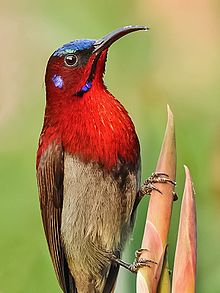| Sunbirds and spiderhunters | |
|---|---|

| |
| Male Vigors's sunbird from Maharashtra, India | |
| Scientific classification | |
| Domain: | Eukaryota |
| Kingdom: | Animalia |
| Phylum: | Chordata |
| Class: | Aves |
| Order: | Passeriformes |
| Superfamily: | Passeroidea |
| Family: | Nectariniidae Vigors, 1825 |
| Genera | |
|
16, see text | |
Sunbirds and spiderhunters make up the family Nectariniidae of passerine birds. They are small, slender passerines from the Old World, usually with downward-curved bills. Many are brightly coloured, often with iridescent feathers, particularly in the males. Many species also have especially long tail feathers. Their range extends through most of Africa to the Middle East, South Asia, South-east Asia and southern China, to Indonesia, New Guinea and northern Australia. Species diversity is highest in equatorial regions.
There are 151 species in 16 genera. Their family name is from most sunbirds feeding largely on nectar,[1] but they will also catch insects and spiders, especially when feeding their young. Flowers that prevent access to their nectar because of their shape (for example, very long and narrow flowers) are simply punctured at the base near the nectaries, from which the birds sip the nectar.[2] Fruit is also part of the diet of some species. Their flight is fast and direct, thanks to their short wings.
The sunbirds have counterparts in two very distantly related groups: the hummingbirds of the Americas and the honeyeaters of Australia. The resemblances are due to convergent evolution brought about by a similar nectar-feeding lifestyle.[3] Some sunbird species can take nectar by hovering like a hummingbird, but they usually perch to feed.
- ^ Jobling, James A. (2010). The Helm Dictionary of Scientific Bird Names. London, England, UK: Christopher Helm. p. 267. ISBN 978-1-4081-2501-4.
- ^ Geerts, S.; Pauw, A. (2009). "Hyper-specialization for long-billed bird pollination in a guild of South African plants: the Malachite Sunbird pollination syndrome". South African Journal of Botany. 75 (4): 699–706. doi:10.1016/j.sajb.2009.08.001.
- ^ Prinzinger, R.; Schafer T.; Schuchmann K.L. (March 1992). "Energy metabolism, respiratory quotient and breathing parameters in two convergent small bird species : the fork-tailed sunbird Aethopyga christinae (Nectariniidae) and the Chilean Hummingbird Sephanoides sephanoides (Trochilidae)". Journal of Thermal Biology. 17 (2): 71–79. Bibcode:1992JTBio..17...71P. doi:10.1016/0306-4565(92)90001-V.